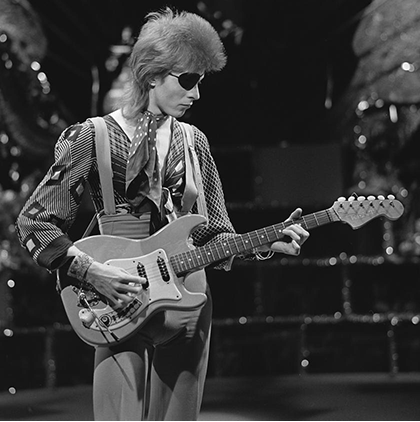Remembering the legacy of David Bowie

David Bowie filming a video for “Rebel Rebel” in 1974.
January 19, 2016
Unfortunately, this year has not started great because of the passing of talented British musician David Bowie after he battled cancer for 18 months. Bowie passed away in Manhattan, N.Y., on Jan. 10 at the age of 69. He will be remembered for opening peoples’ minds to bending music genres and testing the rules of fashion.
Bowie was well known for his outlandish costumes, wild hair color and makeup. His first album was released in 1967, close to the funky 70s, which was the peak of his career. In the 1970s, also known as the glam rock era in music, Bowie began reinventing himself chronically and began creating multiple personas that let him push the limitations of what was deemed acceptable in the fashion world.
He was admired by many fashion designers for his ease of slipping from one style to another while disregarding the restrictions in fashion that were created by society. Bowie not only bent the rules of style but also tested gender boundaries. He would often wear tight-fitting and skin-revealing costumes for his shows with very noticeable makeup that included blue eye shadow and pink cheeks.
With his release of “The Rise and Fall of Ziggy Stardust and the Spiders from Mars” album in 1972, he created the flamboyant persona Ziggy Stardust. This was the beginning of an innovative twist on 1970s fashion. Bowie’s persona Ziggy could be recognized by the futuristic clothing and crazy prints and colors. Even though fashion in the 70s became much more daring by using more colors and drastic silhouettes, Bowie took the period’s fashion style to a new level. He drastically dyed his hair a bright orange-red and dressed in bright prints with a feminine touch. Bowie was not afraid to shock his audience and simply was his eccentric self.
Through his self-confidence, Bowie was able to influence the fashion industry to be more daring. He also was able to influence members of his audience to step out of their comfort zones in fashion.
Bowie continued to come up with new styles and finally created his second persona, the Thin White Duke. This personality was much more subtle and put emphasis on a cabaret style wardrobe. With this persona, Bowie’s outfits mostly consisted of black trousers, white shirts and a waistcoat. This happened during a period of heavy drug use, which played a role in influencing his fashion and how people perceived him.
Another well-known persona that shows the role of his influence on fashion was Jareth the Goblin King. This persona clearly depicted the bold silhouettes of the 80s with tall shoulder pads and untamed hair. This was a style that was heavily used by fashion designers during the era to create a more confident appearance.
Bowie had a constant need to recreate himself, which could be seen through his constant exterior changes such as hair color and new style specific personas. He constantly absorbed new styles and made them his own to exceed the expectations of what was expected of him.
Even today, one can see the effects in fashion Bowie has made in everyday wardrobe. With the 70s style reappearing this past season, resemblances to what Bowie wore during his many personas can be seen on the runway. His style and confidence throughout his career affected many and allowed people to trust in themselves and be who they want to be.






